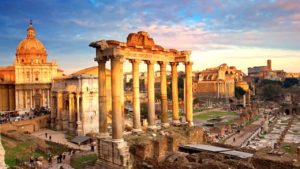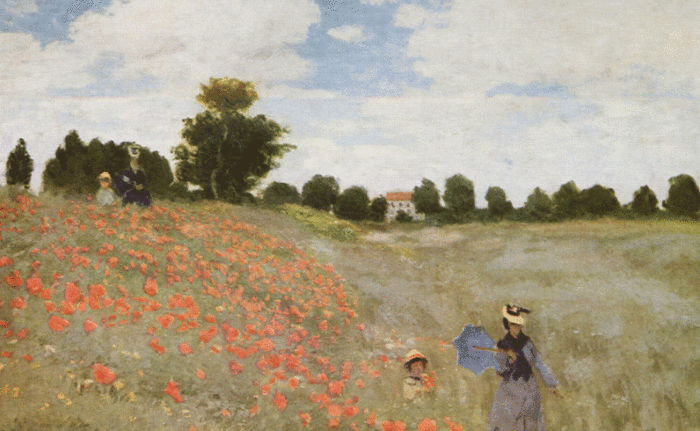On January 9, 11, and 12, the Houston Symphony presents Paganini + “Pines of Rome,” a delightful all-Italian program. In this post, learn how the eternal city inspired Respighi’s most celebrated masterpiece, Pines of Rome.
Though Respighi completed Pines of Rome during the summer of 1924, in an interview he explained that the piece had been “conceived, started, and restarted over several years. Since my first arrival in Rome, two characteristic aspects of the city have all spoken to my imagination above all: the marvelous fountains and the umbrella-like pines that appear in every part of the horizon.” His wife, Elsa, recalled that “This was a period of prodigious activity. His body and soul were in perfect harmony. To anyone looking at him, even casually, he gave the impression of possessing an intense vitality.”
Aside from Rome’s distinctive pine trees, another source of inspiration likely came in 1920 when Elsa had introduced him to some songs she had sung while playing in the Borghese Gardens as a little girl. Snippets of these melodies found their way into the opening movement of Pines of Rome, which indeed depicts children “at play in the pine groves of Villa Borghese,” according to the composer’s own program note. “[T]hey dance round in circles, they play soldiers, marching and fighting, they are wrought up by their own cries like swallows at evening, they come and go in swarms.”
“Suddenly the scene changes,” Respighi writes. The music becomes quiet and still with a deep-voiced chorus of muted strings. “We see the shades of the pine-trees fringing the entrance to a catacomb. From the depth rises the sound of mournful psalmsinging, floating through the air like a solemn hymn, and gradually and mysteriously dispersing.” Muted horns introduce melodic fragments inspired by Gregorian chant, which echo throughout the orchestra until a trumpet solo appears. Marked “sweetly and expressively, as distant as possible,” the trumpet’s melody leads to a chanting figure in the clarinets, horns, and strings. The chant gradually crescendos to a powerful return of the trumpet melody in the trombones, after which the music fades away.

The next section begins with a gentle arabesque from the piano. “A quiver runs through the air: the pine-trees of the Janiculum stand distinctly outlined in the clear light of a full moon. A nightingale is singing.” The Janiculum is a hill located in Rome’s Trastevere neighborhood, across the Tiber from the ancient city. Its eastern slopes are taken up by a park, and the top of the hill provides one of the best views of the city. Traditionally, this part of the piece has been interpreted as a love scene. A solo clarinet begins it with a long melody marked “come in sogno”—“as if in a dream.” The other instruments develop it until the oboe introduces a contrasting idea. A solo cello answers the oboe, and the violins take its arching phrases up into their highest register. The scene ends as it began, with a brief return of the clarinet solo. In an innovative touch, the clarinet is answered by a recording of a nightingale singing, evoking sunrise.

Respighi continues: “Misty dawn on the Appian Way: solitary pine-trees guarding the magic landscape […]”Begun in 312 BCE, the Appian Way was one or the Roman Republic’s most important roads; ending at the Forum, it facilitated Rome’s expansion throughout the southern half of the Italian peninsula. “[T]he muffled, ceaseless rhythm of unending footsteps” emerge as a spectral march from the depths of the orchestra. Slowly, the ghosts come to life in a powerful crescendo: “The poet has a fantastic vision of bygone glories: trumpets sound and, in the brilliance of the newly-risen sun, a consular army bursts forth towards the Sacred Way mounting in triumph to the Capitol.”
In her memoir, Elsa recalled that “The first performance of I pini di Roma took place on December 14 [1924] at the Augusteo,” the ancient mausoleum of the Emperor Augustus which had been converted into a concert hall. “The day before the final rehearsal Respighi confessed to me that the crescendo of ‘I pini della via Appia’ had impressed him in such a way that he felt ‘an I-don’t-know-what’ in the pit of his stomach. This was the first time that I heard him say that a work of his had turned out as he had planned it. […] The last measures of the poem were […] drowned by frenetic applause as had never been heard at the Augusteo. The work was presented again on December 28 at a sold-out performance, and its success echoed immediately throughout the world.” —Calvin Dotsey
Don’t miss Paganini + “Pines of Rome” on January 9, 11, and 12! Learn more & get tickets.



